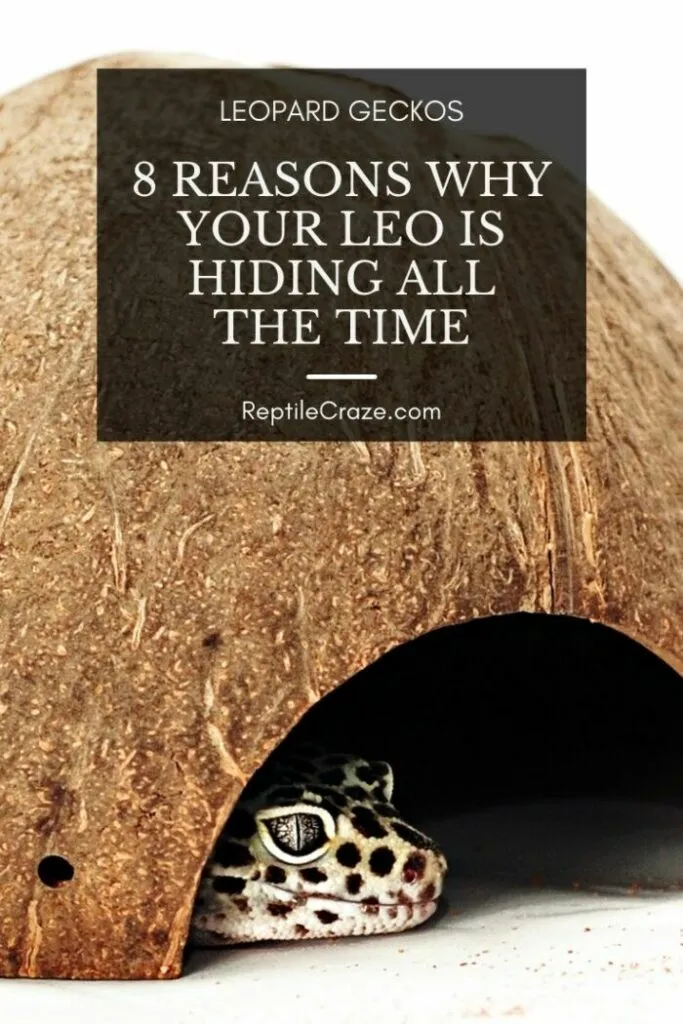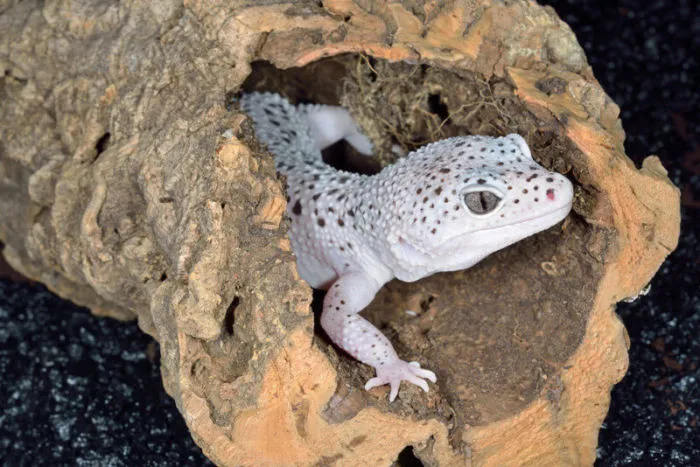
You got a Leopard Gecko because you want to watch it enjoy its enclosure and interact with it, but if it is always in its hide, you may be wondering what’s wrong.
Your Leopard Gecko may always be in its hide because it is newly introduced to the enclosure, it is shedding, in brumation, or it is overweight. Your Leopard Gecko may be frightened or the lights may be too bright. You may also just expect more activity than is natural for your Leopard Gecko.
If you’re concerned about the amount of time that your Leopard Gecko is spending in its hide, here are some explanations for why it may be in its hide as much as it is and some solutions to help it be more active.
Table of Contents
Why is My Leopard Gecko Always in his Hide?
1. Your New Leopard Gecko is Getting a Feel for its Environment
Leopard Geckos typically take some time to adjust to their new home. It is perfectly natural for a Leopard Gecko that you have recently acquired to spend most of its time in its hide.
It is spending its time looking out from the hide to see if any predators come around and also listening and feeling for vibrations that may come from a larger animal that could be a threat.
Once your Leopard Gecko is more accustomed to the rhythm of your home, it should begin to spend more time outside of the hide. Resist the urge to take your Leopard Gecko out of the hide or move the cage around during this adjustment period.
As long as your Leopard Gecko is eating, you have nothing to worry about. Try dangling enticing
If you want to give your leopard gecko a good reason to come out, try these live feeder insects! Leos love them!
Here is a Leopard Gecko coming out of its hide for some
2. Your Leopard Gecko is in Its Moist Hide Because It is Shedding
When Leopard Geckos shed, it is perfectly normal for them to have a reduced appetite and spend more time in their hide. If you notice that your Leopard Gecko is staying in its moist hide, a shed is very likely near.
Leopard geckos require humidity to shed successfully, so they may stay in their moist hide in preparation of a shed. Adult Leopard geckos generally shed every month or so, so if you notice this behavior regularly, it may be part of your gecko’s shedding pattern.
You can tell that a Leopard Gecko is getting ready to shed because its skin will turn duller as it detaches from its body.
3. Your Leopard Gecko is Acting Lazy Because it is Overweight
Leopard Geckos should be a bit plump and have a fat, healthy tail. However, Leopard Geckos can sometimes be prone to obesity.
Older Leopard Geckos tend to slow down and need to eat less, so if you continue to feed your older Leopard Gecko as much as you did when it was younger, it may gain weight.
Leopard geckos tend to be less active when they are very well fed, and extra body weight will slow them down as well, which may result in them spending more time in their hiding place.
Weigh your Leopard Gecko or have your veterinarian check them out to determine whether they need to lose some weight.
Tip: If you would like to avoid unnecessary trips (and costs) you can also book an online vet. They can help you to determine if your leopard gecko has a healthy weight or what to do if it needs to lose weight. You can book an online vet at Vetster, for example.
Here are ideal weights for Leopard Geckos of varying ages:
| Age | Ideal Weight |
| 2 months | 3 grams |
| 6 months | 9 grams |
| 1 year | 29 grams |
| 3 years | 40 grams |
4. Your Leopard Gecko is Hiding From Something in Their Environment
Leopard Geckos are generally pretty easygoing once they are acclimated to a space. Your Leopard Gecko probably won’t mind your movements around their terrarium or even the presence of other pets.
However, every Leopard Gecko is different. If your dog or cat is often near the cage, particularly if they are focused on your Leopard Gecko, your gecko may be frightened of them, causing it to spend more time in its hide.
If you have other Leopard Geckos in the terrarium, your Leopard Gecko may not be getting along well with them, resulting in fearfulness and hiding.
Male Leopard Geckos will typically fight to the death, so if you have more than one male Leopard Gecko in an enclosure, the gecko who is losing the skirmishes may hide from the more dominant gecko.
5. Your Leopard Gecko is Hiding From Lights That are Too Bright
Leopard geckos are crepuscular, so they prefer to be active in the relatively dim light of dawn and dusk. Therefore, they have sensitive eyes to pick up all available light.
Some color strains, like albino Leopard Geckos, may have especially sensitive skin and eyes which may be bothered by bright lights.
While it is important to have a UVB light for your Leopard Gecko, it only needs to be a 5% to even only 2% bulb. Be sure that it is not too close to your Leopard Gecko.
Most UVB bulbs have an insufficient UVB output and burn out quickly. We recommend getting this 5% UVB bulb (check it out here) as it is one of the best you can get.
Also, be sure that any other lights in the room do not shine directly into your Leopard Gecko’s cage.
Sunlight shining through the glass can be particularly dangerous, as it can be concentrated by the glass and result in a lot of heat and too much brightness for your Leopard Gecko.

6. You Expect More Activity Than Leopard Geckos Typically Display
Leopard Geckos are not one of the reptiles that tend to be the most active in their enclosure. It is perfectly normal for a Leopard Gecko to spend most of the daylight hours in its hide since they usually sleep during the day.
In the wild, Leopard Geckos would spend the hot daytime hours hiding and come out only in the early morning, evening, and at nighttime.
If you are used to some other species of lizards like anoles or bearded dragons, you may be expecting basking behavior and more activity throughout the day. Your Leopard Gecko may be behaving perfectly normally by spending most of its time in its hide.
7. Brumation
In the wild, Leopard Geckos go through brumation, which is the reptile version of mammalian hibernation. This typically occurs from December through February. If you keep your Leopard Gecko in a consistent environment year-round, they may not go through brumation.
However, they may notice temperature changes in your home and go through it whether you intend for them to do so or not. Some keepers deliberately create conditions to trigger brumation, as it may result in geckos that are healthier and live longer.
When in brumation, it’s typical for Leopard Geckos to hide for periods of several weeks and have a dramatically reduced appetite.
8. Your Leopard Gecko is Hanging Out in its Hide Because it is Bored
Leopard Geckos enjoy exploring their terrarium, but if there isn’t much to explore, they may just hang out in their hide in between feedings. Try adding rocks, sticks, and different inclines and substrates for your Leopard Gecko to explore.
You can offer a safe digging substrate like Zoo Med Excavator Clay Burrowing Substrate (check it out here) to give your gecko somewhere to dig. When dried out, this substrate gets pretty hard which almost removes the risk that your leopard gecko might accidentally ingest the substrate.
However, you can also mix it with this sand if you want to give your leopard gecko areas that are more solid and areas where your leo can dig a bit.
This video shows you how that is done:
It is best to only use digging substrate in a relatively small portion of the enclosure. Since digging is a natural behavior for Leopard Geckos, they may be stimulated to spend more time out of their hide if given the opportunity to dig.
Important Note: If you are worried that your leopard gecko might get impacted from eating sand, just make sure that your leo gets enough calcium at all times as they only start eating substrate if they have a calcium deficiency. For that, we recommend putting shredded sepia bone (like this one) in a small bowl into the habitat so that your leo can get its minerals whenever it needs it.
How to Convince Your Leopard Gecko to Spend More Time Out of its Hide
If you would like to see more of your Leopard Gecko and are frustrated by how much time it is spending in its hide, there are a few things that you can do to encourage it to spend more time being active.
- Multiple feedings. Your Leopard Gecko will likely come out of its hide to eat, so consider feeding it several times a day so you can enjoy the activity instead of giving it all of its
food at once. Just be sure that you aren’t feeding too often so that your gecko is able to get enough sleep. - Create a natural light cycle. If your lights get brighter in the morning and dim as it becomes evening, your Leopard Gecko may be more likely to come out in the morning and evening when you can see them rather than just being active at night time.
- Provide an interesting environment. Leopard geckos are more likely to leave their hide and explore if they have an interesting enclosure in which to wander around, so try varying the environment every so often.
Check your knowledge on Leopard Geckos by fill out our Leopard Gecko Quiz
Enjoy a More Active Leopard Gecko
You want to see your Leopard Gecko and enjoy them, so it can be frustrating if your gecko is always in its hide.
Leopard Geckos will spend a certain amount of their time each day in their hide, but by ensuring that your gecko’s environment meets its needs and by varying the enclosure and feeding schedule, you can see a lot more of your gecko.
- Enchi Ball Python: A Unique and Stunning Morph of Python regius - March 27, 2025
- Emerald Tree Monitor: The Enigmatic Green Guardian of the Rainforest - March 26, 2025
- The Egyptian Cobra (Naja haje): A Fascinating Serpent - March 25, 2025
